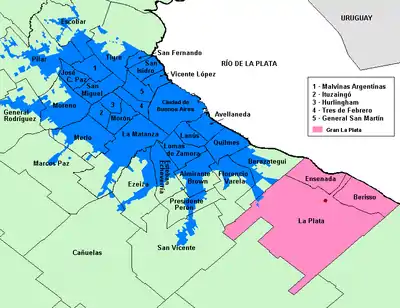Cocoliche
Cocoliche[1] is an Italian–Spanish mixed language or pidgin that was spoken by Italian immigrants in Argentina (especially in Greater Buenos Aires) and Uruguay between 1870 and 1970. In the last decades of the 20th century, it was replaced with or evolved into Lunfardo.[2]

History
Between 1880 and 1910, Argentina and Uruguay received a large number of Italian immigrants, mostly poor country folk who arrived with little or no schooling in the Spanish language and often were only semi-literate or totally illiterate in their Italian languages.
As those immigrants strove to communicate with the local criollos, they produced a variable mixture of Spanish with Standard Italian (Florentine) and Italian languages, which was given the derogatory name Cocoliche by the locals.[3]
Another example of a language influence is Cocoliche, which takes its name from Antonio Cuculicchio, a theater worker in the Podestá theater company established in Argentina and Uruguay towards the end of the nineteenth century. An Italian immigrant, Cuculicchio’s accent was apparently often mocked by others, giving rise to the comical caricature of a figure called “Cocolicchio”, representing a southern Italian. Cocoliche is a hybrid language that arose from the meeting of Spanish in Argentina and Italian brought to that country by immigrants around the turn of the twentieth century. The result was a pidgin—an oral form of communication that blended elements of two languages to foster communication between diverse groups of people, in some cases simplifying the grammar and lexicon of each language.
— Translation Blog, Transpanish
Italian proper never took hold very well in Argentina, especially because most immigrants used their local languages, and were not proficient in the standard language. This prevented the development of an Italian-language culture. Since the children of the immigrants grew up speaking Spanish at school, work, and military service, Cocoliche remained confined mostly to the first and second generation of Italian immigrants, and slowly fell out of use. The pidgin was depicted humorously in literary works and in the Argentine sainete theater, e.g. by Dario Vittori.
The area where most Italian emigrants and their descendants spoke the Cocoliche was near the port of Buenos Aires, mainly in the barrios Belgrano and Palermo. These two areas were 70% speaking "Cocoliche" at the beginning of the 20th century.
Additionally it is noteworthy to pinpoint that it was in the "barrio" La Boca of Buenos Aires, where the local slang at the end of the XIX century was the Genoese dialect called "Xeneise", that was used for the first time the word "Lunfardo" by those Genoese for the language/dialect used by the local criminals (mostly Italians but even Spanish, French, Portuguese, Indian, etc...): later in the XX century the Lunfardo assimilated the Cocoliche, that disappeared after World War II.
Influence
Many Cocoliche words were transferred to the Lunfardo (a local Spanish dialect that some linguists -like Garbarino- think it is a mixture of Spanish, Lombard, and Italian). For example:
- manyar (to eat) from Venetian and Lombard "magnar" (mangiare in Italian)
- lonyipietro (fool)
- fungi (mushroom) -> in Lunfardo: hat
- vento (wind) -> in Lunfardo: money
- matina (morning) from Italian "mattina"
- mina (girl) from Lombard "mina" (busty woman or prostitute)
- laburar (to work) from Italian "lavorare"
- minga (nothing) from Lombard "minga" (negative particle like not in English or ne pas in French)
- yeta (bad luck) from Neapolitan "iettatore"
- yira (to go for a walk) from Italian "girare"
- salute (cheers) from Italian "salute"
- fiaca (laziness) from Italian "fiacca"
Some of these words show a characteristic codialect evolution, for example in the case of manyar, the word manyar exists with the same meaning in Spanish even though it is considered jargon and not proper Spanish, being derived from Occitan manjer and reinforced by the Italian mangiare.
See also
- Adoniran Barbosa, composer in the analogous Italian-Portuguese pidgin.
- Italian settlement in Argentina
- Lunfardo
Notes
External links
- (in Italian) Cocoliche e Lunfardo: l'italiano dell'Argentina
- (in Spanish) What is lunfardo